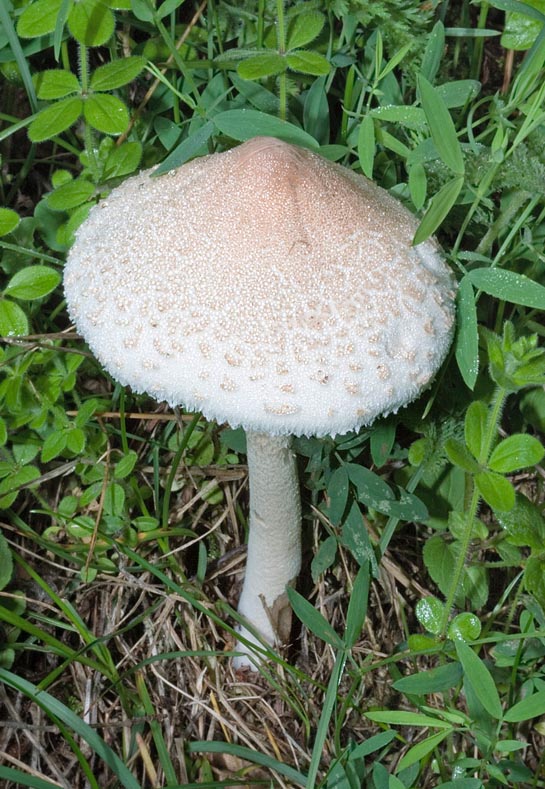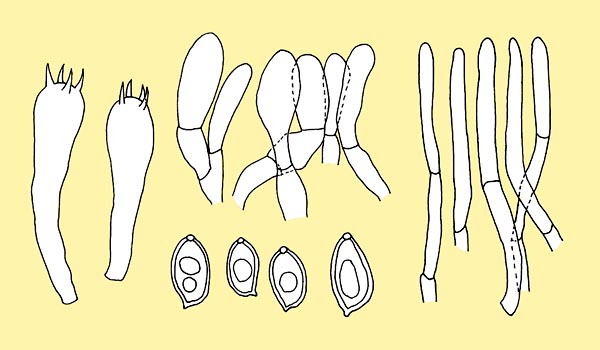
Text © Pierluigi Angeli

English translation by Mario Beltramini

Macrolepiota mastoidea seems a titty breast and is edible © Giuseppe Mazza
Family: Agaricaceae Chevallier, 1826.
Genus: Macrolepiota Singer, 1948.
Section: Macrolepiota Bon, 1981.
Subsection: Microsquamatae (Pázmány) Bellù & Lanzoni, 1987.
Macrolepiota mastoidea (Fries : Fries) Singer, 1951.
The epithet “mastoidea”, similar to breast, due to the huge central umbo which recalls the nipple, comes from the Greek “mastós” = breast, and “eîdos” = appearance.
It is a very common species and, like all abounding fungi, it holds several common names.
In Italy it is known as “mazza di tamburo”, because similar to the Macrolepiota procera “colombina dei monti”, “piccolo scarogia”; in France “Lépiote mamelonnée”; in Spain “parasol”, “palo de tambor”; in Germany “Zitzen-Riesenschirmling”, “Spitzbuckliger Schirmling”, “Warzenschirmling”, “Warzen-Schrimpilz”, “Zitzen”, “Zitzenwarziger Riesenschirmpilz”.
Description of the genus, section and subsection
For the description of the genus please refer to the text concerning the Macrolepiota procera.
To the section Macrolepiota are ascribed medium and big species, having the cap with big scales and a double ring, movable on the stipe. Clamp connections are present at the base of the basidia and in the hyphae in the lower face of the ring, but are difficult to locate.
To the subsection Microsquamatae belong species of medium size, having small scales on the cap, simple ring which at times has enlarged and scaly margin, movable on the stipe. Clamp connections are present in the sub-hymenium and in the surface of the stipe.
Description of the species
Cap: 7-12 (14) cm, initially conical-campanulate, then campanulate and finally flat, with pronounced umbo, breast-shaped; margin initially inrolled, then stretched, protruding on the gills; the cuticle, of ocherous, cream-ochre, light brown colour, cracks in small scales, initially adpressed then increasingly rare, especially at the margin, where they allow to see the white-cream colour of the background, the centre is of a more or less dark brown colour.
Hymenium: thick gills, intercalated by several lamellulas, spaced, with collar, initially white then cream, the thread, of the same colour, is entire.
Stipe: 8-15 x 1-1,5 cm, slender, cylindrical, attenuated on top, wide at the base which ends in a bulb, fistulose, fibrillose; surface finely decorated by pale ochre mottles, almost of the same colour as the cap on whitish background. Membranous ring, simple, the upper face is initially white then brownish, the lower one is whitish.

Macrolepiota mastoidea spores, basidia, cheilocystidia and pileipellis © Pierluigi Angeli
Flesh: thick in the centre and thin in the margin, soft, fibrous in the stipe, almost no odour, mild taste.
Habitat: it grows in summer and in autumn, in the glades of the broad-leaved trees woods.
Edibility : edible.
Microscopy: ellipsoidal spores, smooth, with germinative pore, dextrinoid, 12,1-16,5 × 7-9,9 µm. Clavate, tetrasporic basidia, with rare clamp connections, 27,5-52 × 9,9-14,3 µm. Fusiform, clavate, cheilocystidia, 20,9-57,2 × 8-14,3 µm. Epicutis formed by a trichoderm of cylindrical hyphae, with the last element attenuated on top or clavate, measuring 43,5-98,6 × 8,7-9,5 µm.
Remarks: it’s an easy to recognize fungus, especially thanks to the cap which presents a very pronounced umbo and small scales which leave the edge uncovered; the stipe is finely ornamented by pale ochreous woolly tufts or scales on a whitish or pale cream background.
It is possible to mistake it with Macrolepiota rickenii (Velenovsky) Bellù & Lazzari 1987, which, however, has shorter stipe and the same is more proportionate to the diameter of the cap, the decorations on the stipe and on the cap are less evident and paler; Macrolepiota affinis (Velenovsky) Bon 1977, always ascribed to the subsection Microsquamatae, which, however, has a fine decoration on the cap as well as on the stipe formed by small scales of the same colour, in the hyphae of the pileipellis does have a vacuolar pigment associated with a membranary one.
Synonyms: Agaricus mastoideus Fries 1821, basionym; Lepiota mastoidea (Fries) P. Kummer 1871; Leucocoprinus mastoideus (fries) Singer 1939; Lepiotophyllum mastoideum (Fries) Locquin Marcel V.1942; Lepiota excoriata subsp. mastoidea (Fries) Quélet 1888.
→ For general notions about Fungi please click here.
→ To appreciate the biodiversity of MUSHROOMS please click here.
